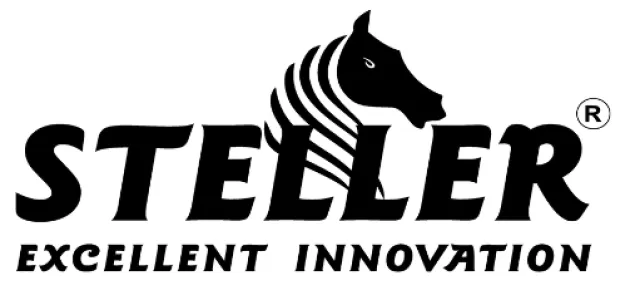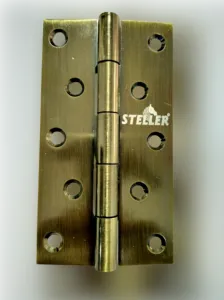Buy Butt Hinges Online at Wholesale Price
A hinge functions as a movable joint, linking two items together. It’s a widely recognized category within mechanical bearings. Among these, butt hinges stand out – a specific hinge type comprising rectangular pieces affixed to two parallel components. This connection allows the parts to close upon each other, facilitating a swinging motion spanning up to one hundred and eighty degrees (180°). In common with all hinges, butt hinges feature a knuckle, pin, and two leaves. The leaves are brought together by the pin, inserted through the knuckle. Unlike conventional hinges, butt hinges showcase a mortised structure, characterized by a hole, groove, or slot accommodating another component. Consequently, they’re also referred to as mortise hinges. Ball bearing butt hinges are available in various materials, like stainless steel, aluminium, brass, etc.
Table of Contents
A hinge boasting identical leaves is termed a butt hinge. Notably, butt hinges often sport a larger knuckle compared to alternative hinge types. When closed, the broad knuckles of a butt hinge ensure that the two leaves sit flush against each other.
How do butt hinges work?
These hinges operate based on their simple yet effective design. Pushing or pulling the door causes one hinge leaf to rotate around the pin, while the other leaf remains fixed. This pivotal motion enables the door to swing open or close. The smooth rotation of the hinge eliminates unnecessary strain on both the door and the frame, promoting their longevity and ease of use.
To install a butt hinge, one leaf is mortised or recessed into the edge of the door, while the other is similarly placed on the door frame. The accuracy of the mortise and installation greatly influences the hinge’s functionality and the overall alignment of the door.
People choose butt hinges for their reliability, stability, and straightforward operation. They frequently use them in pairs, with two hinges supporting the door’s weight and ensuring balanced movement. The versatility and effectiveness of butt hinges have made them a popular choice for a wide range of applications, from interior doors to kitchen cabinets, providing the essential swinging function required in everyday use.
Considerations in choosing butt hinges
A butt hinge is a compact, durable, and reliable hinge option suitable for a wide range of door installations, including cabinet doors, entrance doors, and exterior gates. However, several considerations come into play when choosing a butt hinge, contingent upon its intended application area and primary purpose.
Strength
In instances where hinges need to support substantial weight, opting for heavy-duty hinges is essential. These butt hinges, often crafted from galvanized steel, stainless steel, aluminium, die-cast zinc, or acrylonitrile butadiene styrene (ABS), ensure the necessary strength to bear the load.
Corrosion resistance
When hinges operate in damp environments, corrosion becomes a critical concern. Selecting corrosion-resistant hinges is vital. Materials for butt hinges such as galvanized steel, stainless steel, aluminium, and nylon exhibit excellent corrosion resistance. Coatings or paint can also act as protective measures against oxidation.
Heat resistance
For locations with elevated temperatures, the choice of hinge material is crucial. Opting for materials like galvanized stainless steel for butt hinges, known for its heat-resistant properties, ensures that the hinge performs reliably even in extreme temperatures.
Impact resistance
In scenarios where hinges may experience forceful impacts, considering materials like acrylonitrile butadiene styrene (ABS) is prudent, as it offers inherent impact resistance.
Durability
Hinges’ longevity is influenced by the materials they interact with. The material of the hinge should match that of the components it engages with. Durable butt hinges materials encompass die-cast zinc, aluminium, nylon, stainless steel, and galvanized steel.
Weight compatibility
Choose hinges that are compatible with the weight of the door. For example, opt for stainless steel butt hinges if you have heavy doors. For lightweight options, choose aluminium butt hinges.
Easy maintenance
For scenarios where frequent hinge maintenance or replacement is expected, stainless steel and aluminium butt hinges are preferred. Their durability and ease of cleaning make them a suitable choice.
Aesthetics
Hinges are often integrated into doors and furniture with aesthetics in mind. They play a crucial role in maintaining a seamless appearance while performing their functional duties.
Hinge orientation
Hinge orientation refers to the direction of rotation or movement around the door. Select between left-handed and right-handed hinges based on the door’s swing and style, ensuring a harmonious fit.
Design features
When delving into the design features of butt hinges, understanding their components and specifications is essential to ensure the right fit for your application. Here’s a closer look at these design elements:
Leaf
The leaves are the flat, elongated parts of the hinge that attach to the door and the frame. They determine the hinge’s overall strength and stability. Choosing leaves with appropriate materials and dimensions ensures proper weight distribution and secure attachment.
Leaf width
The width of the leaf corresponds to the width of the door or cabinet. Selecting the correct width ensures a balanced distribution of weight and optimal functionality.
Leaf length
The length of the leaf dictates the height of the door or cabinet. Proper leaf length contributes to seamless movement and prevents binding.
Leaf thickness
The thickness of the leaf affects the hinge’s strength and durability. Thicker leaves provide enhanced support for heavier doors, while thinner leaves are suitable for lighter applications.
Knuckle or Barrel
The knuckle, also known as the barrel, is the cylindrical part that connects the two leaves and the pin. Choosing a knuckle size that accommodates the pin and provides smooth movement is crucial for proper hinge operation.
Pitch
The pitch refers to the distance between the knuckles. It determines how closely the leaves fit together when the hinge is closed. Proper pitch selection prevents gaps and ensures a snug closure.
Paint clearance
To prevent interference when painting doors or cabinets, opt for hinges with sufficient paint clearance, allowing the door to open and close smoothly even with a painted surface.
Countersunk holes
Countersunk holes on the leaves allow the screws to sit flush, creating a neat and secure attachment that prevents snagging or interference with the door’s movement.
Pin
The pin is the central component that holds the leaves together and enables rotational movement. Choosing a high-quality pin material ensures smooth operation and longevity.
End play
End play refers to the slight vertical movement allowed by the hinge when the door is closed. Proper end play accommodates natural variations in door height and ensures consistent contact with the frame.
Types of butt hinges
Butt hinges, known for their reliability and versatility, come in a multitude of types and materials like stainless steel and aluminium, each designed to cater to specific needs and preferences. Delve into the details of these hinge varieties to find the perfect fit for your project:
Plain butt hinges
The epitome of simplicity, plain butt hinges consist of two flat leaves joined by a pin. Renowned for their robustness, these traditional hinges suit a wide range of applications, from doors to cabinets.
Ball tip butt hinges
Combining functionality with elegance, ball-tip butt hinges feature decorative spherical tips at the ends of the leaves. These hinges not only facilitate smooth movement but also contribute to the aesthetic appeal of the installation.
Ball-bearing hinges
Enhancing the smooth operation of hinges, ball-bearing hinges incorporate ball bearing between the knuckles. This feature results in quieter, friction-free movement, making them an excellent choice for frequently used doors.
Rising butt hinges
Rising hinges incorporate a unique mechanism that lifts the door slightly as it swings open. This design prevents friction between the door and the floor, making them suitable for areas with uneven surfaces or carpets.
Spring butt hinges
Spring hinges include integrated springs that automatically close the door after it’s opened. Often used in spaces that require self-closing doors, such as commercial kitchens or fire doors.
Electric butt hinges
Designed for modern security and access control systems, electric hinges include wiring that enables integration with electronic locking mechanisms, adding an extra layer of functionality to your doors.
Offset hinges
When you need a door to sit further forward or backward within a frame, offset hinges come to the rescue. They accommodate specific design or functional requirements without compromising on stability.
Lift-off hinges
Perfect for scenarios where doors need frequent removal, lift-off hinges enable easy detachment without disassembling the hinge itself. Maintenance and door adjustments become hassle-free.
Concealed hinges
Concealed hinges marry form and function by hiding within the door and frame, resulting in a sleek appearance. Designers frequently select them for minimalist and contemporary styles.
Overlay (cabinet) hinges
Specially crafted for cabinets, overlay hinges allow doors to overlap the cabinet frame, concealing the edges for a clean and refined look. Their adjustability ensures a perfect fit.
Leaf hinges
Featuring two flat plates connected by a pin, leaf hinges provide straightforward rotational movement. Their simplicity makes them versatile and well-suited for various projects.
Corner hinges
Addressing the challenges of corner installations, corner hinges allow doors to swing smoothly around the corner, eliminating the need for special frames or modifications.
Double-action hinges
In busy environments like restaurants or commercial kitchens, double-action hinges shine. They enable doors to swing in both directions, facilitating effortless movement in high-traffic areas.
Applications of butt hinges
Butt hinges find widespread applications across various sectors, spanning domestic, medical, industrial, military, and agricultural realms. The selection of the appropriate type of butt hinge depends on its intended purpose.
The medical sector employs robust, lead-lined hinges for radiation and neutron shielding in doors, vaults, and medical equipment. Similarly, heavy-duty hinges secure research facilities against radiation. Military contexts rely on heavy hinges for guarded doors, transporters, and armoured vehicles. At home, hinges feature in doors, windows, cupboards, and entertainment units.
Chemical processing factories employ heavy-duty hinges on large processing containers for environmental preservation while shipping containers use hinges for security. Ball-bearing butt hinges shine for frequently used or hefty entryway doors.
Industries like oil and gas leverage these hinges for mobility, offering stability for large gates. LCD screens, laptop screens, and illuminated wall cladding use ball-bearing hinges. Marine equipment integrates hinges for loading and unloading.
Building sites and agricultural machinery employ diverse hinge types for gates and equipment. Piano hinges find utility in fold-down desks and storage benches. Offset hinges accommodate wide openings for disability access. Butt hinges prove invaluable across sectors, tailored to meet specific needs and contribute to seamless functionality.
Advantages & disadvantages of butt hinges
Advantages of butt hinges
- Durability: Their robust construction makes butt hinges a dependable choice, ensuring enduring performance and reliability, even with frequent use.
- Stability: The design of hinges provides stable support, making them suitable for heavy doors and gates.
- Simplicity: Butt hinges have a straightforward design, making them easy to install and maintain.
- Versatility: You can use these hinges in various applications, including doors, cabinets, furniture, and gates.
- Smooth operation: Properly installed hinges facilitate smooth swinging motion, ensuring ease of use.
- Customization: These butt hinges are available in various materials like stainless steel and aluminium etc., sizes, and finishes, allowing for customization to match specific requirements and aesthetics.
Disadvantages of butt hinges
- Limited swing range: Traditional butt hinges offer a swing range of up to 180 degrees, which might be restrictive in certain applications.
- Space requirement: Butt hinges require clearance space for proper movement, which can impact the arrangement of adjacent objects or furniture.
- Visible hardware: In some cases, these hinges might be visible when the door is open, affecting the overall aesthetics of the installation.
- Maintenance: Over time, the pins and knuckles of butt hinges may require lubrication to maintain smooth operation.
- Installation expertise: Proper installation is crucial for optimal performance, and inexperienced installation can lead to misalignment or binding.
- Weight limitation: While butt hinges can handle substantial weight, heavy doors might require additional hinges or alternative hinge types for better weight distribution.
In summary, butt hinges offer durability, stability, and versatility, making them a popular choice for many applications. However, they come with limitations like swing range and installation requirements, which should be carefully considered based on the specific needs of the project.
Top butt hinge brands in India
- Hafele: Hafele provides a comprehensive range of butt hinges, including single-action spring hinges, ball-bearing flush hinges, and various sizes of butt hinges in SS 304 material. They offer different designs and types catering to specific needs like square corners, round corners, and more.
- Hettich: Hettich is known for manufacturing reliable and durable hardware products, and they offer a diverse range of butt hinges suitable for various applications.
- Indobrass: Indobrass offers ball-bearing hinges in various sizes. These hinges are designed to provide smooth operation and durability. Indobrass is recognized for manufacturing quality brass hardware.
- TAITON: TAITON offers a variety of butt hinges, including four ball-bearing hinges in different sizes. These hinges are designed for durability and reliable performance, meeting the requirements of various door applications.
- STELLER: A reputed hardware brand, STELLER has been serving a range of reliable door hardware and manufacturing fittings. They have a variety of premium stainless steel welded door hinges.
Why buy from the biwholesale.com online store?
Our website showcases butt hinges sourced from renowned brands in the industry, known for crafting dependable hardware components. Our pride lies in efficiently fulfilling large-scale and export orders, providing customized solutions, and engaging in OEM manufacturing. We aim to be your comprehensive supplier, offering a one-stop shop experience.
Butt Hinge – Price List
| Product Name | Price |
| 1. TAITON Pin Butt Hinge without Bearing (TA-BH NBB 4 x 2.5 x 2.5 | Rs. 108 |
| 2. Indobrass Ball Bearing Butt Hinges | Rs. 306 |
| 3. TAITON Four Ball Bearing Butt Hinges (TA-BH 4BB 5 x 3 x 3) | Rs. 459 |
| 4. TAITON Four Ball Bearing Butt Hinges (TA-BH 4BB 4 x 3 x 3) | Rs. 351 |
| 5. Hettich Ball Bearing 4″ x 3″ x 3 AB Square Hinge | Rs. 958 |
| 6. (Pack of 10) STELLER Welded Premium Hinges | Rs. 524 |
| 7. (Pack of 10) STELLER Welded Premium Hinge | 5 x 12 | Rs. 923 |
| 8. Hafele Butt Hinge | SS 304 | 5″ x 3″ x 3 mm | 2 Ball Bearing | Square Corner | Rs. 344 |
| 9. (Pack of 30) STELLER Welded Premium Hinge | 3×16 | Rs. 788 |
| 10. TAITON Pin Butt Hinge without Bearing (TA-BH NBB 5 x 2.5 x 2.5) | Rs. 137 |
This data was last updated on 27/12/2024
FAQs
How are butt hinges installed?
To install butt hinges, attach one leaf to the door and the other to the door frame. Secure them by driving screws through holes in the leaves and into the frame or door. Proper alignment during installation is crucial for the smooth operation of the hinge. Ensuring that the hinge plates are level and properly positioned helps prevent binding or misalignment.
Do butt hinges require maintenance?
Yes, regular maintenance is beneficial for the longevity of butt hinges. Over time, dirt and dust can accumulate in the hinge mechanism, leading to friction and reduced performance. It’s advisable to periodically lubricate the hinge pins with a suitable lubricant to ensure smooth movement. Cleaning the hinges and tightening any loose screws is also part of routine maintenance.
Can butt hinges be adjusted for door alignment?
Yes, many butt hinges come with adjustment features. These adjustments allow for fine-tuning the alignment of the door. By loosening or tightening the screws on the leaves, you can ensure that the door fits perfectly within the frame, preventing gaps or binding. Adjustability is particularly useful when the door or frame settles over time.
Do butt hinges allow doors to swing in both directions?
No, traditional butt hinges are designed for one-way swinging motion. If you need a door to swing in both directions, double-action hinges are the appropriate choice. In commercial settings, like restaurant kitchen doors, double-action hinges find common use as they allow doors to swing open and close in both directions.
What materials are commonly used for a butt hinge?
These hinges are made from various materials, each chosen for specific qualities. Stainless steel is popular for its corrosion resistance, making these hinges suitable for both indoor and outdoor use. Brass and bronze butt hinges offer a classic look and durability, while zinc and aluminium butt hinges are often used for their lightweight properties. The choice of material depends on factors like the environment, aesthetics, and intended use.
How many butt hinges are typically used per door?
The number of butt hinges required per door depends on the door’s size, weight, and intended use. Standard practice is to use two butt hinges for doors up to 60 inches in height. Taller or heavier doors might require three hinges for proper weight distribution and stability.
Are ball bearing hinges suitable for different door materials, such as wood or metal?
Yes, these hinges are versatile and compatible with various door materials. Whether the door is made of wood, metal, composite, or other materials, butt hinges can be effectively used, provided the proper size and weight-bearing capacity are chosen.
How do I determine the right size of butt hinge for my door or cabinet?
To determine the right size of butt hinge, measure the width and height of the door or cabinet. The size of the hinge should be proportionate to these dimensions. Additionally, consider the weight of the door or cabinet, as heavier doors might require larger and stronger hinges for proper support.
What is a removable pin butt hinge, and how does it differ from a regular butt hinge?
A removable pin butt hinge has a feature that allows you to easily remove the pin connecting the two leaves. This enables the door to be taken off without the need to uninstall the entire hinge. Regular butt hinges lack this feature, requiring the complete disassembly of the hinge to remove the door. Particularly convenient, removable pin hinges allow for easy door removal during maintenance, painting, or temporary adjustments.



 Häfele
Häfele Hettich
Hettich Indobrass
Indobrass STELLER
STELLER TAITON
TAITON











